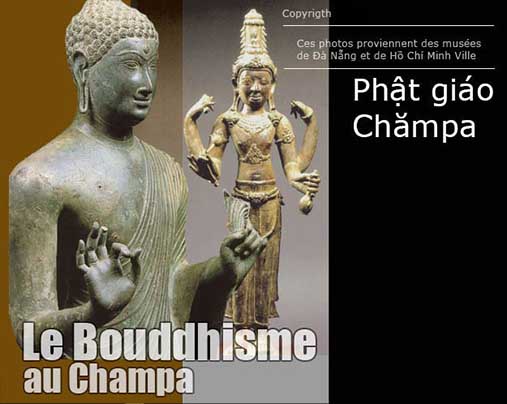
Version vietnamienne
Version française
The discovery of a large number of Mahayana elements, particularly statues of the deity Avalokitesvara, the most popular and revered icon of Mahayana Buddhism, undeniably marks the strengthening of its establishment and doctrine in Champa and testifies to the benevolence of the Cham sovereigns. This special royal consideration allowed it to remain a secondary religion, living for several centuries in the shadow of Hinduism, patiently awaiting its time of glory and influence. It was in the 8th and 9th centuries that, after embracing certain countries such as the Khmer Empire and the kingdoms of Srivijaya and Sailendra, Mahayana Buddhism found its full flourishing in accordance with the arrival of the new ruling Bhrgu lineage in the person of Indravarman II. It is also in the Chinese annals (for example, Tân Đường Thư) that the name « Tchan-Tcheng » (or Campapura (Chiêm Thành in Vietnamese)) appeared for the first time, replacing Huanwang (Hoàn Vương), which had until then been linked to the royal lineage of Prathivindravarman of the South (Kauthara) (Nha Trang).
Having transferred the capital to Indrapura (near Hội An) (or Faifo) in the Amaravati region (Quảng Nam and Quảng Ngãi), Indravarman II showed a particular personal inclination towards Mahayana Buddhism despite maintaining Shaivism as the state religion. It cannot be ignored that King Indravarman II had the opportunity to recall in his royal inscriptions that sovereignty over Champa had come to him solely by the favor of destiny and thanks to merits acquired in many previous existences. It seems that through this teaching, he was more or less attached to the doctrine of Buddhism, particularly to the accomplishment of spreading the Dharma, more than any other Cham king who found his salvation in union with Shiva. According to Georges Coedès, he was designated by Vikrântavarman III, who died without offspring, at the request of the great sages of the kingdom. What is remembered about this king is his Buddhist fervor, his extraordinary wisdom, and his unwavering faith in Lokesvara (Lord of the World). In 875, he had an important Buddhist temple erected in his capital Indrapura on the Đồng Dương site, not far from the Mỹ Sơn sanctuary where the national god Shiva Bhadresvara resided, and he entirely dedicated it to his personal god, Laksmindra-Lokesvara.

We also see in the choice of the name of this temple a practice now used by the Cham sovereigns, always associating the name of the protective deity with that of the donor of the establishment. Despite the primary worship of Shiva for his devastating powers and brilliant victories in protecting the kingdom, the veneration of Lokesvara, representing a Buddha or Avalokitesvara (a bodhisattva), symbolizes not only peace and benevolence but also the protection of this deity over the country and its inhabitants, so much so that Hinduism and Buddhism, although different philosophically and religiously, can now coexist in Champa. According to the French archaeologist Henri Parmentier, the Buddhist site Đồng Dương also seems to encompass the king’s residence located at what is today called « ao vuông » (square-shaped pond). It appears that there is a secret water current that can communicate with a well located one kilometer to the east of the site. The construction of this site demonstrates a desire for innovation in grouping many isolated buildings within an imposing architectural achievement where the presence of Chinese and Indian influences is undeniable.
This is what is discovered in the general plan of this site. In its architecture and sculpture, certain aspects of the borrowing from Chinese art can be seen in terms of monumentality and power, while in the composition of the liturgical scenes and narrative panels there is an impeccable fidelity to the decorative conventions found in the temples of western India.
The construction of this site develops along an east-west axis 1300 meters long, with numerous brick buildings spread across three successive enclosures, each controlled by an entrance pavilion guarded by formidable and terrifying stone guardians (dvarapala). According to Henri Parmentier‘s description, it was in the western half of the first enclosure that he found in 1905 the most important sanctuary (1), probably housing the statue of Laksmindra-Lokesvara to whom the site was dedicated in 875 by King Indravarman II. This main sanctuary is preceded by a tower open to the four cardinal points (thap sang) and surrounded by 9 small temples arranged in a well-ordered layout.
For most Vietnamese researchers, the great masterpiece of bronze art that a peasant found by chance in 1978 while looking to collect some bricks in the ruins near the first enclosure, often referred to as Tara (Phật mẫu Tara), is none other than the statue of Laksmindra-Lokesvara (Quan Âm chuẩn đề). It is indeed Avalokitesvara appearing in a feminine form as a Bodhisattva (Bồ tát Quán Thế Âm) because in both hands, at the time of its discovery, a lotus and a conch were found.[Reading more]
